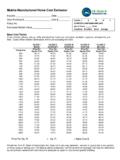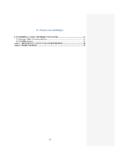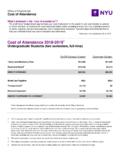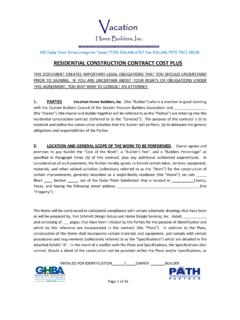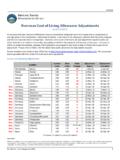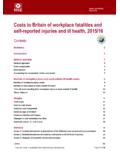Transcription of 18R-97: Cost Estimate Classification System - As …
1 AACE International Recommended Practice No. 18R-97. cost Estimate Classification System AS APPLIED IN. ENGINEERING, PROCUREMENT, AND CONSTRUCTION FOR. THE PROCESS INDUSTRIES. TCM Framework: cost Estimating and Budgeting Acknowledgments: Peter Christensen, CCE (Author) Kenneth K. Humphreys, PE CCE. Larry R. Dysert, CCC (Author) Donald F. McDonald, Jr. PE CCE. Jennifer Bates, CCE C. Arthur Miller Dorothy J. Burton Bernard A. Pietlock, CCC. Robert C. Creese, PE CCE Wesley R. Querns, CCE. John K. Hollmann, PE CCE Don L. Short, II. Copyright 2005 AACE, Inc. AACE International Recommended Practices AACE International Recommended Practice No. 18R-97. cost Estimate Classification System AS APPLIED. IN ENGINEERING, PROCUREMENT, AND CONSTRUCTION. FOR THE PROCESS INDUSTRIES. TCM Framework: cost Estimating and Budgeting February 2, 2005. PURPOSE. As a recommended practice of AACE International, the cost Estimate Classification System provides guidelines for applying the general principles of Estimate Classification to project cost estimates ( , cost estimates that are used to evaluate, approve, and/or fund projects).
2 The cost Estimate Classification System maps the phases and stages of project cost estimating together with a generic maturity and quality matrix, which can be applied across a wide variety of industries. This addendum to the generic recommended practice provides guidelines for applying the principles of Estimate Classification specifically to project estimates for engineering, procurement, and construction (EPC) work for the process industries. This addendum supplements the generic recommended practice (17R-97) by providing: a section that further defines Classification concepts as they apply to the process industries;. charts that compare existing Estimate Classification practices in the process industry; and a chart that maps the extent and maturity of Estimate input information (project definition deliverables). against the class of Estimate . As with the generic standard, an intent of this addendum is to improve communications among all of the stakeholders involved with preparing, evaluating, and using project cost estimates specifically for the process industries.
3 It is understood that each enterprise may have its own project and estimating processes and terminology, and may classify estimates in particular ways. This guideline provides a generic and generally acceptable Classification System for process industries that can be used as a basis to compare against. It is hoped that this addendum will allow each user to better assess, define, and communicate their own processes and standards in the light of generally-accepted cost engineering practice. INTRODUCTION. For the purposes of this addendum, the term process industries is assumed to include firms involved with the manufacturing and production of chemicals, petrochemicals, and hydrocarbon processing. The common thread among these industries (for the purpose of Estimate Classification ) is their reliance on process flow diagrams (PFDs) and piping and instrument diagrams (P&IDs) as primary scope defining documents. These documents are key deliverables in determining the level of project definition, and thus the extent and maturity of Estimate input information.
4 estimates for process facilities center on mechanical and chemical process equipment, and they have significant amounts of piping, instrumentation, and process controls involved. As such, this addendum may apply to portions of other industries, such as pharmaceutical, utility, metallurgical, converting, and similar industries. Specific addendums addressing these industries may be developed over time. This addendum specifically does not address cost Estimate Classification in nonprocess industries such as commercial building construction, environmental remediation, transportation infrastructure, dry . processes such as assembly and manufacturing, soft asset production such as software development, and similar industries. It also does not specifically address estimates for the exploration, production, or transportation of mining or hydrocarbon materials, although it may apply to some of the intermediate processing steps in these systems. The cost estimates covered by this addendum are for engineering, procurement, and construction (EPC) work only.
5 It does not cover estimates for the products manufactured by the process facilities, or for research and development work in support of the process industries. This guideline does not cover the Copyright 2005 AACE, Inc. AACE International Recommended Practices cost Estimate Classification System As Applied in Engineering 2 of 9. Procurement, and Construction for the Process Industries February 2, 2005. significant building construction that may be a part of process plants. Building construction will be covered in a separate addendum. This guideline reflects generally-accepted cost engineering practices. This addendum was based upon the practices of a wide range of companies in the process industries from around the world, as well as published references and standards. Company and public standards were solicited and reviewed by the AACE International cost Estimating Committee. The practices were found to have significant commonalities that are conveyed in this addendum.
6 cost Estimate Classification MATRIX FOR THE PROCESS INDUSTRIES. The five Estimate classes are presented in figure 1 in relationship to the identified characteristics. Only the level of project definition determines the Estimate class. The other four characteristics are secondary characteristics that are generally correlated with the level of project definition, as discussed in the generic standard. The characteristics are typical for the process industries but may vary from application to application. This matrix and guideline provide an Estimate Classification System that is specific to the process industries. Refer to the generic standard for a general matrix that is non-industry specific, or to other addendums for guidelines that will provide more detailed information for application in other specific industries. These will typically provide additional information, such as input deliverable checklists to allow meaningful categorization in those particular industries.
7 Primary Secondary Characteristic Characteristic EXPECTED PREPARATION. LEVEL OF. ACCURACY EFFORT. PROJECT END USAGE METHODOLOGY. RANGE Typical degree of DEFINITION Typical purpose of Typical estimating Estimate Typical variation in effort relative to Expressed as % of Estimate method CLASS low and high least cost index of complete definition ranges [a] 1 [b]. Capacity Factored, Parametric Models, L: -20% to -50%. Class 5 0% to 2% Concept Screening 1. Judgment, or H: +30% to +100%. Analogy Equipment L: -15% to -30%. Class 4 1% to 15% Study or Feasibility Factored or 2 to 4. H: +20% to +50%. Parametric Models Semi-Detailed Unit Budget, Costs with L: -10% to -20%. Class 3 10% to 40% Authorization, or 3 to 10. Assembly Level H: +10% to +30%. Control Line Items Detailed Unit cost Control or Bid/ L: -5% to -15%. Class 2 30% to 70% with Forced 4 to 20. Tender H: +5% to +20%. Detailed Take-Off Detailed Unit cost Check Estimate or L: -3% to -10%. Class 1 50% to 100% with Detailed Take- 5 to 100.
8 Bid/Tender H: +3% to +15%. Off Notes: [a] The state of process technology and availability of applicable reference cost data affect the range markedly. The +/- value represents typical percentage variation of actual costs from the cost Estimate after application of contingency (typically at a 50% level of confidence) for given scope. [b] If the range index value of 1 represents of project costs, then an index value of 100 represents Estimate preparation effort is highly dependent upon the size of the project and the quality of estimating data and tools. Copyright 2005 AACE, Inc. AACE International Recommended Practices cost Estimate Classification System As Applied in Engineering 3 of 9. Procurement, and Construction for the Process Industries February 2, 2005. Figure 1. cost Estimate Classification Matrix for Process Industries CHARACTERISTICS OF THE Estimate CLASSES. The following charts (figures 2a through 2e) provide detailed descriptions of the five Estimate classifications as applied in the process industries.
9 They are presented in the order of least-defined estimates to the most-defined estimates . These descriptions include brief discussions of each of the Estimate characteristics that define an Estimate class. For each chart, the following information is provided: Description: a short description of the class of Estimate , including a brief listing of the expected Estimate inputs based on the level of project definition. Level of Project Definition Required: expressed as a percent of full definition. For the process industries, this correlates with the percent of engineering and design complete. End Usage: a short discussion of the possible end usage of this class of Estimate . Estimating Methods Used: a listing of the possible estimating methods that may be employed to develop an Estimate of this class. Expected Accuracy Range: typical variation in low and high ranges after the application of contingency (determined at a 50% level of confidence). Typically, this results in a 90% confidence that the actual cost will fall within the bounds of the low and high ranges.
10 Effort to Prepare: this section provides a typical level of effort (in hours) to produce a complete Estimate for a US$20,000,000 plant. Estimate preparation effort is highly dependent on project size, project complexity, estimator skills and knowledge, and on the availability of appropriate estimating cost data and tools. ANSI Standard Reference (1989) Name: this is a reference to the equivalent Estimate class in the existing ANSI standards. Alternate Estimate Names, Terms, Expressions, Synonyms: this section provides other commonly used names that an Estimate of this class might be known by. These alternate names are not endorsed by this Recommended Practice. The user is cautioned that an alternative name may not always be correlated with the class of Estimate as identified in the chart. CLASS 5 Estimate . Description: Estimating Methods Used: Class 5 estimates are generally prepared based on very Class 5 estimates virtually always use stochastic limited information, and subsequently have wide accuracy estimating methods such as cost /capacity curves and ranges.


